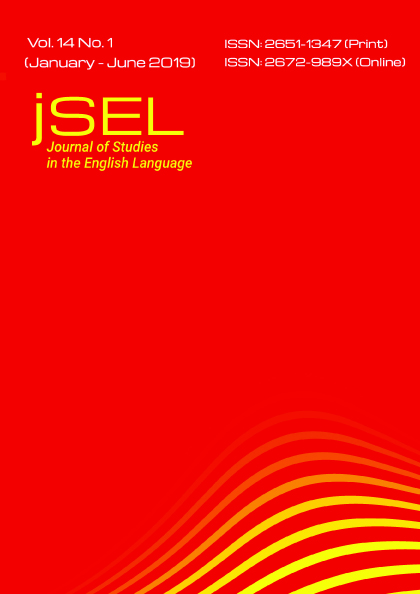A Corpus-based Study of Linking Adverbials in Written American English
Main Article Content
Abstract
In this study, we investigate uses of linking adverbials in present-day written American English, in response to an observation from a previous study that occurrences of linking adverbials may vary according to varieties of English. The American English 2006 corpus (Potts & Baker, 2012) was utilized for the purpose of the study. Distribution patterns of linking adverbials were examined in the light of their categories and text genres, namely general prose, academic prose, fiction, and media texts. The results showed that among the four text genres, linking adverbials occur most frequently in academic prose and least frequently in fiction and media texts. The distribution patterns of linking adverbials by category revealed that the additive group occurs most frequently across the board while the sequential group the least. These overall findings correspond to previous studies of linking adverbials in other varieties of English, thereby suggesting that uses of linking adverbials are associated with text genres and categories, rather than with varieties. However, it is also found that such major distribution tendencies are not shared by a large number of linking adverbials in each group. This suggests that individual LAs have their idiosyncratic usage patterns, and these are associated with their frequencies in each genre. Analysis of some individual LAs revealed that there are other contextual factors, apart from text genres, including textual positions and co-occurrence patterns, which deserve attention in future research on linking adverbials.
Article Details
References
Biber, D., & Gray, B. (2016). Grammatical complexity in academic English: Linguistic change in writing. Cambridge, UK: Cambridge University Press.
Biber, D., Johansson, S., Leech, G., Conrad, S., & Finegan, E. (1999). Longman grammar of spoken and written English. Harlow, UK: Longman.
Brown, G., & Yule, G. (1984). Discourse analysis. Cambridge, UK: Cambridge University Press.
Celce-Murcia, M., & Larsen-Freeman, D. (1999). The grammar book: An ESL/EFL teacher’s course (2nd ed.). Boston, MA: Heinle & Heinle.
Conrad, S. M. (1999). The importance of corpus-based research for language teachers. System, 27(1), 1–18. https://doi.org/10.1016/S0346-251X(98)00046-3
Gilquin, G., Granger, S., & Paquot, M. (2007). Learner corpora: The missing link in EAP pedagogy. Journal of English for Academic Purposes, 6, 319–335. https://doi.org/10.1016/j.jeap.2007.09.007
Granger, S., & Paquot, M. (2009). Lexical verbs in academic discourse: A corpus-driven study of learner use. In M. Charles, D. Pecorari, & S. Hunston (Eds.), Academic writing: At the interface of corpus and discourse (pp. 193–214). London, UK: Continuum.
Ha, M. J. (2016). Linking adverbials in first-year Korean university EFL learners’ writing: A corpus-informed analysis. Journal Computer Assisted Language Learning, 29(6), 1090–1101. https://doi.org/10.1080/09588221.2015.1068814
Hardie, A. (2012). CQPweb — combining power, flexibility and usability in a corpus analysis tool. International Journal of Corpus Linguistics, 17(3), 380–409.
Ishikawa, S. (2010). A corpus-based study on Asian learners’ use of English linking adverbials. Themes in Science and Technology Education, 3, 139–157.
Leedham, M., & Cai, G. (2013). Besides … on the other hand: Using a corpus approach to explore the influence of teaching materials on Chinese students’ use of linking adverbials. Journal of Second Language Writing, 22(4), 374–389. https://doi.org/10.1016/j.jslw.2013.07.002
Lei, L. (2012). Linking adverbials in academic writing on applied linguistics by Chinese doctoral students. Journal of English for Academic Purposes, 11, 267–275. https://doi.org/10.1016/j.jeap.2012.05.003
Liu, D. (2008). Linking adverbials: An across-register corpus study and its implications. International Journal of Corpus Linguistics, 13(4), 491–518. https://doi.org/10.1075/ijcl.13.4.05liu
Mackey, A., & Gass, S. M. (2016). Second language research: Methodology and design (2nd ed.). New York, NY: Routledge.
Potts, A., & Baker, P. (2012). Does semantic tagging identify cultural change in British and American English?. International Journal of Corpus Linguistics, 17(3), 295–324. https://doi.org/10.1075/ijcl.17.3.01pot
Ro, S. H., & Na, Y. H. (2012). Use and misuse of linking adverbials: A corpus-based study on NS and NNS writings. English21, 25(3), 291–317. Retrieved from https://www.earticle.net/Article.aspx?sn=196792
Saville-Troike, M. (2012). Introducing second language acquisition (2nd ed.). Cambridge, UK: Cambridge University Press.
Sinclair, J. (1991). Corpus, concordance, collocations. Oxford, UK: Oxford University Press.
Shaw, P. (2009). Linking adverbials in student and professional writing in literary studies: What makes writing mature. In M. Charles, D. Pecorari, & S. Hunston (Eds.), Academic writing: At the interface of corpus and discourse
(pp. 215¬–235). London, UK: Continuum.
Stubbs, M. (2007). Quantitative data on multi-word sequences in English: The case of the word world. In M. Hoey, M. Mahlberg, M. Stubbs, & W. Teubert (Eds.), Text, Discourse and Corpora: Theory and Analysis (pp. 163–190). London, UK: Continuum.
Swales, J. M., & Feak, C. B. (2012). Academic writing for graduate students (3rd ed.). Ann Arbor, Michigan: University of Michigan Press.
Webb, S., & Nation, P. (2017). How vocabulary is learned. Oxford, UK: Oxford University Press.


